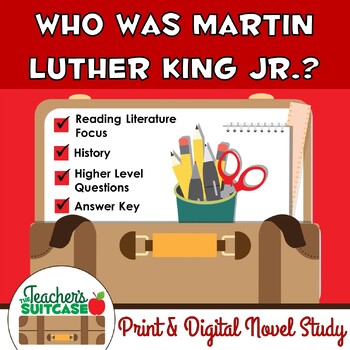Who Was Martin Luther King Jr.? {Black History Month Novel Study} PRINT/DIGITAL
- Zip
- Google Apps™
- Easel Activity

What educators are saying
Also included in
- The Who Was? Series Book Bundle contains five novels focusing on Black History Month and Presidents Day. These products are PRINT & DIGITAL through GOOGLE SLIDES and EASEL by TPT. The following novels are ready for DISTANCE LEARNING. Who Was Martin Luther King Jr.?Who Was Rosa Parks?Who Was HPrice $19.96Original Price $24.95Save $4.99
Description
Who Was Martin Luther King, Jr.? novel study is now a PRINT and DIGITAL resource through GOOGLE SLIDES and EASEL by TPT. This resource is ready for DISTANCE LEARNING.
Connect American History and literature by reading the novel Who Was Martin Luther King Jr.? by Bonnie Bader.
Included in this Black History Month novel study are:
Printer Friendly Novel Study
11 Pages of Comprehension Questions with an Answer Key
11 Pages of Extension Activities – Reading Literature Focus
- KWHL – Who Was Martin Luther King Jr.?
- Summary - Jim Crow Laws
- Drawing Conclusions - Mahatma Gandhi
- Beginning, Middle & End - Montgomery Alabama: The Cradle of the
Confederacy - Main Idea and Details - Rosa Parks
- Problem and Solution - The Fifteenth Amendment
- Fact and Opinion - Brown v. The Board of Education
- Symbolism - Major Features of the Civil Rights Act of 1964
- True or False – The Gettysburg Address
- Making Connections – Nobel Peace Prize & Civil Rights Leaders
- Thick Questions – Watts Riots
- Cause and Effect – James Earl Ray
Martin Luther King Jr. was a civil rights activist who led non-violent protests to fight for the rights of African Americans. He dreamed that America and the world could become a colorblind society where race did not matter. Martin Luther King Jr. won the Noble Peace Prize in 1964 and his speeches still inspire many to this day.
In this unit, students will learn about Martin Luther King Jr.’s role in establishing new laws in the United States and the challenges he faced while promoting equal rights. His story of determination will enthrall your students and inspire them to learn more about influential black Americans.
Are you looking for more Who Was novels?
Who Was Rosa Parks? {Black History Month Novel Study} - PRINT & DIGITAL
Who Was Harriet Tubman? {Black History Month Novel Study} - PRINT & DIGITAL
Who Was Abraham Lincoln? {Presidents' Day Novel Study} - PRINT & DIGITAL
Who Was George Washington? {Presidents' Day Novel Study} PRINT & DIGITAL
Happy Learning!
Renee Smalley
You may also be interested in…
New and Exciting Novel Activities
Book Projects for ANY Fiction Novel {Dodecahedron Puzzle, Story Cube, & More}.
Interactive Notebook Novel Studies
A to Z Mysteries - Activities for any Novel in the Series {Interactive Notebook}.
The Magic Tree House - Any Fiction Novel in the Series {Interactive Notebook}.
Harry Potter and the Sorcerer's Stone Novel Study & Interactive Notebook.
Best Selling Novel Studies
Tales of a Fourth Grade Nothing {Novel Study & Art Project}.
The BFG {Novel Study, Art Project, & Common Core}.
Bunnicula {A Rabbit Tale Mystery-Comedy}.
The Best Christmas Pageant Ever {Novel Study and Flip Book}.
Island of the Blue Dolphins {Comp. Questions, Research Folder, & Art Project}.
Sideways Stories from Wayside School {Novel Study and Writing Project}.
Newbery Winning Novel Studies
Because of Winn-Dixie {Novel Study & Story Pyramid Book Project}.
The Tale of Despereaux {Novel Study & Figurative Language Flip Book}.
The One and Only Ivan {Novel Study, Comprehension Questions Fan & Game Board}.
Flora & Ulysses: The Illuminated Adventures {Novel Study & Superhero Project}.
Number the Stars {Novel Study, Picture Dictionary, & Antique Writing Project}.
Shiloh {Novel Study & Interactive Movie Packet}.
Roald Dahl Novel Studies
Matilda {Novel Study & Interactive Movie Packet}.
Charlie and the Chocolate Factory {Dodecahedron Puzzle, Novel Study, & Bingo}.
Classic Novel Studies
The Lion, the Witch, and the Wardrobe {Novel Study & Pyramid Art Project}.
Gregor the Overlander {By the Author of The Hunger Games}.
The Indian in the Cupboard {Questions & Reading/Writing Activities}.
Superfudge {Novel Study, Accordion Book Project, & CCSS}.
Gregor and the Prophecy of Bane {By the Author of The Hunger Games}.
The Magician's Elephant {Novel Study, Story Cube, & Word Wall}.
Wonder by R.J. Palacio {Comprehension, Art, Writing, Vocabulary, & Bully Bingo}.






